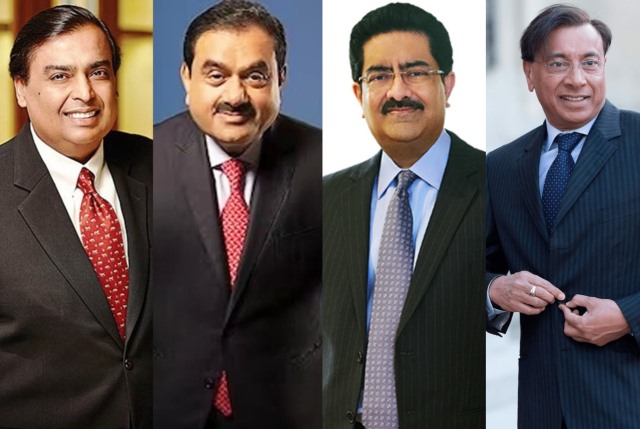
Why India’s Richest Don’t Want to Give their Wealth Away
Michael Bloomberg, the former mayor of New York City and the founder of the financial, software, and data company, Bloomberg L.P., could well be the world’s most exceptional living philanthropist. Over his lifetime, Bloomberg, who is 82, has given away a staggering $17.4 billion to various charitable causes. That sum, in Indian rupees, is 1.44 lakh crore. Bloomberg’s dedication to improving education, public health, and social equality has left an indelible mark, making him one of the most influential philanthropists of our time.
In 2023 alone, Bloomberg contributed $3 billion to support the arts, education, environment, public health, and programs aimed at improving city governments around the world. In the same year, according to a ranking by Hurun, a research, media and investments group, the top 10 Indian philanthropists together donated ₹5,800 crore or $700 million. In Indian media, it was widely described as an impressive contribution that made a significant impact. To put it in perspective, however, the sum that the top 10 Indian philanthropists donated together is a little less than 25% of what Bloomberg donated in the same year.
Bloomberg is not richer than the richest Indian, by the way. He is actually poorer. Bloomberg’s net worth, according to the Forbes real-time ranking of billionaires, is $106.2 billion. The richest Indian, according to the same Forbes list, is Mukesh Ambani, with a net worth assessed at $117.5 billion. Ambani ranked as the ninth richest person in the world. And, in 2023, he and his family, according to the Hurun Philanthropy list (which happens to be the only credible and authentic estimation of Indian philanthropy), made a donation of ₹376 crore or, if you are into comparisons, $45 million. As stated before, in the same year, Bloomberg, who is the 12th richest person in the world, contributed $3 billion.
The number of Indian billionaires has been growing apace every year. According to Forbes, a record number of Indians, 186 in total, have made it to Forbes’ 2024 World’s Billionaires list, an increase from 169 last year. The total number of billionaires in the world is estimated by Forbes to be 2,555, a staggering 19-fold increase since 1987. American billionaires, unsurprisingly, account for the highest number–735 on the Forbes list but for a country that accounts for one of the world’s largest population of poor people (according to the Multidimensional Poverty Index, which considers factors like health and education, 14.96% of Indians are in multidimensional poverty), 186 billionaires is a massive number.
Yet, the number of Indians among the world’s biggest philanthropists is appallingly small. In fact, the biggest philanthropists in India aren’t the richest, and even as the number of Indian billionaires burgeons, the amount that they give away remains paltry. Interestingly, one of the greatest philanthropists of all time was an Indian pioneer industrialist and founder of the Tata group, Sir Jamsetji Tata who passed away more than a century ago. Tata began his endowments in 1892 and his lifetime donations are estimated to be worth $102.4 billion, which is many times what today’s India’s richest businessmen together donate.
The Indians that do lead in philanthropy are ones that keep a far lower profile than their headline-grabbing richer peers. The two biggest philanthropists in India today are Shiv Nadar, 78, and Azim Premji, also 78. Both built their fortunes primarily in technology. Premji started with his father’s cooking oil and soap making business and founded Wipro, a multinational corporation that provides information technology, consultant and business process services. Nadar is a first-generation entrepreneur who started HCL, a technology multinational similar to Wipro.
Last year, Nadar and his family donated ₹2,042 crore mainly to arts, culture, and heritage; and Premji donated ₹1,774 crore primarily to education. In dollar terms, their contributions, $214 million and $246 million, respectively, hardly match what the world’s billionaire philanthropists donate but in India, they are far bigger philanthropists than their richer peers who control bigger Indian business conglomerates.
Why don’t India’s Rich Give Away their Money?
One easy answer is that they probably fear the taxman. Many Indian businessmen own their businesses (and, ergo, their wealth) through intricate webs of holding companies that help them minimise the taxes they have to pay on their incomes and wealth. To be seen to be forking out large sums to good causes could attract unwanted attention. Indeed, many rich Indians do like to donate and when they do, they prefer to be anonymous.
Some of the available figures of corporate or individual donations may also not be accurate. The relationship between wealth and philanthropy in India is complex. While some wealthy individuals actively engage in charitable giving, others may not contribute as significantly. Then there are traditional and historical factors. India has a strong tradition of religious giving. Many affluent individuals donate to temples, religious institutions, and festivals. This form of charity is deeply ingrained in Indian culture and may not show up on philanthropy lists and rankings.
The emergence of wealthy and super-rich Indians is also a new phenomenon. Many among India’s growing breed of new rich have built first- or second-generation wealth and are not yet secure enough to donate part of that. It could take a couple more generations before philanthropy becomes a more widespread practice. Thus, wealthy Indians often prioritise supporting their extended families, including education, healthcare, and other needs. This familial responsibility can sometimes take precedence over broader philanthropic efforts.
India wants to be a global economic superpower. Many believe it is on its way to becoming one. In the last quarter, the Indian economy, according to official figures, grew at 8.4%, which is far higher than most of the world’s big economies, and last week Prime Minister Narendra Modi said “with this speed, India will become the world’s third-largest economy.” At the same time, India grapples with extreme income inequality. The gap between the rich and the poor is stark, and the country’s developmental needs are huge. That is why India’s rich ought to take philanthropy more seriously, and that is why individuals such as Premji and Nadar are exceptions who should become examples to follow.
For more details visit us: https://lokmarg.com/
Their life philosophy and love for wealth to be left entirely for the next generation may not be allowing the rich Indians to practise philanthropy in the same way as their counterparts in the US in particular. Let us accept the fact, Indians are not Americans in any way. The children of rich Indian families may go to the US colleges, but when they return to manage family businesses, they are not very different from their fathers and grandfathers. Well the new generation has a fondness for the acquired American accent but with no interest in what Bloomberg and Bill Gates are doing with their wealth.
Interestingly, promoters of companies here consider the money spent on corporate social responsibility (CSR) account, though obliged by law, to be family philanthropy. The house of Tata is an exception. A large portion of Tata Sons dividend income from Tata enterprises, TCS and the rest goes to support many humanitarian causes, including health and education. As Narayan suggests, Shiv Nadar and his wife Kiran Nadar and Azim Premizi are exceptions. Nadar has set up a university, which is becoming stronger by the year and Azim Premzi Foundation is a lot about quality education and building good citizens. It is another matter that the rich in general in India are not inspired by such acts.
On the contrary, there are any number of instances of school and college teachers on retirement will be found giving back large portions of retirement benefits to the institutions they have served. Institutions like IITs, IIMs, Presidency College in Calcutta and Jadavpur University are all facing fund crunch. Why not the Indian rich open their purse for the rescue of these iconic educational establishments?



